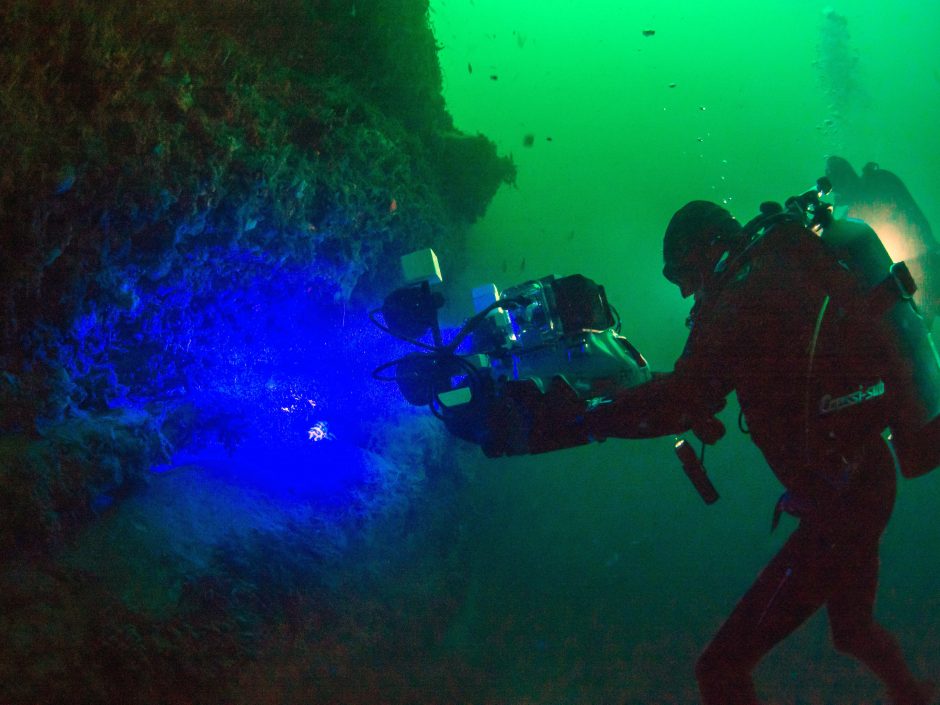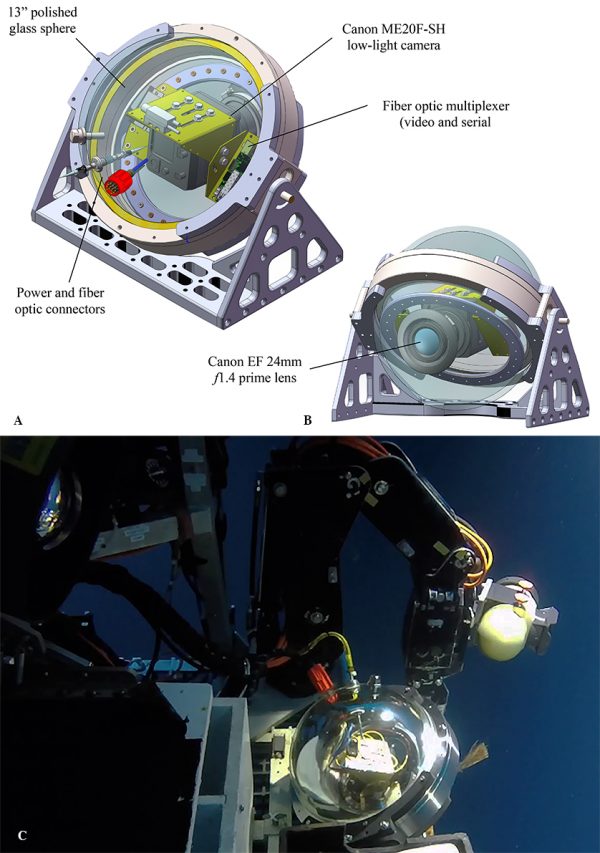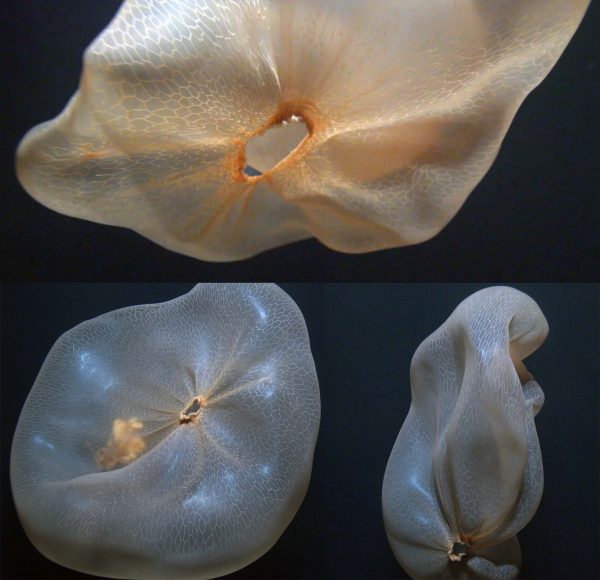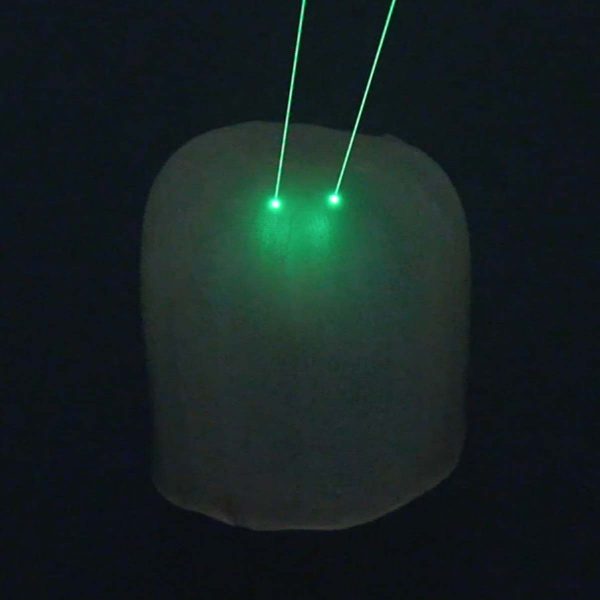Advanced Technologies, Deep Waters, and Surprise Jellyfish

David Gruber imaging with shark-eye camera. (Credit: courtesy of David Gruber)
This year land dwellers everywhere can catch some crisp, detailed images of a rarely seen deep-sea jellyfish, Deepstaria enigmatica, with nothing more than an internet connection. City University of New York (CUNY) professor Dr. David Gruber and a research team caught their surprise encounter with the Deepstaria off the coast of Mexico with the help of a specially designed underwater camera.
“We were not looking for Deepstaria enigmatica. Deepstaria enigmatica found us!” exclaims Dr. Gruber. “On most deep-sea explorations, we are usually the first people to view the dark, submerged seascapes. Our planet is 71% covered by oceans, that’s, on average, over 12,000 feet deep. We have only recently had the technology to explore these deep ocean ecosystems. We bumped into this mysterious Deepstaria jelly at 3,195 feet.”
The right tech for any job
The Deepstaria was spotted via a research partnership between CUNY and the Dormitory Authority of the State of New York (DASNY). The still images and video both offer an amazing level of clarity.
“Due to the tremendous pressure of the deep sea, there are just a handful of specialized companies who sell equipment to explore the deep ocean,” details Dr. Gruber. “The main client is usually the oil and gas industry or the military. But, as marine biologists studying delicate deep-sea life, this is not always appropriate for us. So we develop our own tools.”
At the moment, Dr. Gruber and his team are busy.

Composite Canon ME20. (Credit: From Gruber et al. 2018)
“Via a collaboration with Prof. Robert Wood’s Lab at Harvard’s Wyss Institute for Biologically Inspired Engineering, we’re developing ‘Squishy Robots‘ or soft underwater robotics that can delicately interact with marine life,” Dr. Gruber describes. “We’re also developing a suite of low-light cameras that can withstand the pressure of the deep sea (here is another example). The aim of using low-light color cameras is to both explore the deep-sea without shocking deep marine life as well as to photograph and study bioluminescent animals. Most of the animals in the deep sea have the capability to produce their own light, a process called bioluminescence. The light they produce is so dim that we cannot use a flash or lights to capture it. Imagine trying to focus your lens and photograph a firefly at night in the forest without using any light. That is essentially what we are doing in the deep sea.”
The team’s equipment is designed to compensate for the low light conditions to get both clarity and good color.
“Even the most sensitive low-light cameras need some light to capture an image,” remarks Dr. Gruber. “In the deep sea, it is perpetually dark, and no photons from the sun reach below about 700 meters. Due to the sensitivity of our low-light cameras, we can now drive submarines or remotely operated vehicles using the equivalent of a pen light. This is much preferred to the usual bright driving lighting. As biologists, using dim light is extremely important, since these animals are never exposed to bright lights. It would be like trying to study the behavior of nocturnal animals in the forest using powerful searchlights. They would obviously have a significant impact.”
Deepstaria encounter
A lucky encounter turned into a very informative find in this case.
“This Deepstaria jelly just appeared out of the darkness,” Dr. Gruber comments. “At first, we could not tell what it was—we could just see its shape. It looked like a floating trash can. As it got closer, its features became more pronounced and it began purse its bell. We turned on our lasers, so we could get an idea of its size—the beams are spaced 10cm apart. As Deepstaria approached our camera, we could see its fine features, like her unique anastomosing canals that are used for digestion and circulation. They are the most beautiful dendritic patterns, like artwork.”

Composite closed Deepstaria. (Credit: From Gruber et al. 2018)
The team was then able to locate and observe an active jellyfall, a find that’s still relatively rare.
“The jellyfall was found at 2,950 feet among a dense assemblage of sponges and corals,” states Dr. Gruber. “We noted it was a hot spot for lithodid crabs and caridean shrimp who were congregating around the jelly, with some eating it. That had not been seen before. It made us think of how important of a food source Deepstaria might be to deep-sea bottom dwellers.”
This successful application highlights the importance of this relatively unobtrusive technology for observing rare species such as Deepstaria; but will it become the standard for this kind of work?
“I hope so!” Dr. Gruber remarks. “It seems to make so much sense to use our advanced technology in ways that are less obtrusive and delicate to deep-sea animals. Another aspect is age. Some deep-sea animals and corals can be thousands of years old! That is another reason we are inspired to be delicate when exploring this foreign terrain.”

Deepstaria getting measured with lasers. (Credit: From Gruber et al. 2018)
For Dr. Gruber and the team, there are many other exciting new technologies and projects on the horizon.
“We are developing ‘shark-eye‘ cameras and “turtle-eye” cameras (inspired by this discovery),” explains Dr. Gruber. “We are developing a new suite of ‘squishy robots’ for delicate deep-sea interactions (here is one example). We are working on the chemical pathway in which bioluminescent animals produce light. We are also starting a project on sperm whale bioacoustics.”
Top image: David Gruber imaging with shark-eye camera. (Credit: courtesy of David Gruber)




0 comments